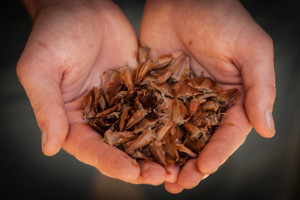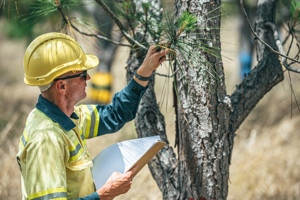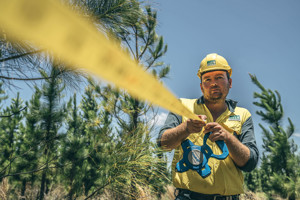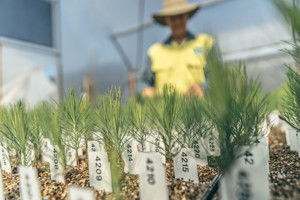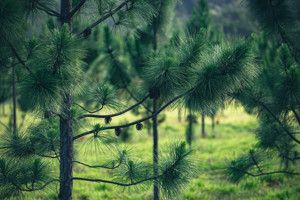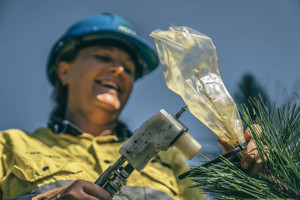There’s more to our plantation forests than meets the eye
There are decades of expertise behind every tree we produce, and we are always investing in research, development and extension to support contemporary and innovative plantation management practices.
These investments help to strengthen business performance and resilience and maintain our social license. They support our strategic priorities, including business value, risk management, operational excellence and sustainable stakeholder relationships.

Our research, development and extension (RD&E) investment portfolio is structured around seven key themes, listed below.
To support our RD&E, we collaborate with various industry representative bodies and research providers including Forests and Wood Products Australia, the Australian Forest Products Association, CSIRO, Tree Breeding Australia and several universities.
You can also read more about how our research and innovation supports forest management and to increase plantation productivity and value, enhance sustainability and minimise risk.
Our RD&E investment key themes
-
The focus of our sustainable production RD&E theme is very broad and addresses priorities relating to:
- nursery systems for the reliable production of low cost, healthy and robust seedlings
- integrated, cost-effective plantation re-establishment systems resulting in high seedling survival (> 90%) and rapid early seedling growth and site capture
- safe and sustainable production systems, supported by communities and delivering environmental benefits
- silvicultural regimes well suited to target end use products that maximise net returns within a sustainable framework.
Example projects include:
- survival and field growth comparisons between Araucaria seedlings raised in plastic versus biodegradable coir pots
- impact of beneficial mycorrhiza (applied in the nursery) on Southern Pine seedling development and subsequent field performance
- evaluation of novel post-harvest site clearing and cultivation implements and machine-based fertiliser applicators in coastal lowland Southern Pine estates in terms of impacts on safety, operating costs, plantation survival and long term growth
- evaluation of alternative chemicals for woody weed control
- impacts of woody weeds on survival, early growth and later age productivity in Southern Pines
- mid-rotation fertilising to boost Southern Pine productivity and value return
- monitoring ( for survival, growth and wood quality) and reporting an extensive range of Long Term Treatment Response (LTTR) trials that compare various combinations of genetics, site preparation, fertiliser, weed control and thinning treatments
- impacts of harvesting operations and post-harvest cultivation treatments on soil compaction and subsequent (Araucaria) crop growth
- impacts of Southern Pine stump removal and remedial cultivation on the subsequent crop and broader plantation growing environment.
-
We have three key areas of focus for genetic improvement:
Hybrid Southern Pine - maximise gains in growth, wood quality and site adaptability to produce structural grade timber in 26 years or less.
Tropical Southern Pine - improve seed orchards to balance productivity and windthrow risks.
Araucaria - implement a long-term seed supply strategy that balances gains in growth, straightness, internode length and genetic diversity.
Southern Pine projects include:
- progeny trials - continued creation (crossing), testing and selection of best Hybrid Pine families in field trials (cloned progeny trials) across representative sites in SEQ
- top grafting - improve top grafting efficiency in Hybrid Pine clone banks, reducing breeding cycle interval and improving the efficiency and safety of controlled pollination
- graft incompatibility - identify broadly compatible rootstocks for orchards and clone banks
- pollen contamination - monitor development of trial seed orchard at Imbil, isolated from Hybrid Pine pollen contamination sources
- molecular approaches - evaluate molecular tools for integration into traditional breeding programs to accelerate gains
- wood quality screening - select for improved early age stiffness using non-destructive evaluation techniques including ST300 acoustic tool and resi tool to support reduced rotation age goals
- active participation in FWPA project - tools, systems and enabling genetic technologies for pines and eucalypts
- continued representation on Tree Breeding Australia technical advisory committee
- hybrid pines - testing for drought and disease resistance
- tropical pines - identify best individuals in family within taxa trials in north Queensland for later conversion to seedling seed orchards.
Araucaria projects include:
- strategic Review - review status of all genetic trials and data sets, and conduct later age measures of priority trials
- Yarraman clonal seed orchard - finalise grafting based on best available information
- gene conservation - review existing gene conservation resources in clone banks and orchards and recommend long term strategies to manage risks.
-
We utilise remote sensing applications from various platforms (satellite, aerial, drone, terrestrial) to reduce costs and improve accuracy, precision and timeliness of plantation characterisation. Example projects include:
- FWPA Project: Next generation resource assessment and forecasting for Australian plantation forestry
- FWPA Project: Operational immersive visualisation and measurement of dense point cloud data in forest inventory
- support for wider adoption of LiDAR
- hyperspectral imaging for softwoods
- evaluate potential of ground-based LiDAR (hovermap) to support resource assessments, research trial assessments and characterisation of pruning status in Araucaria stands
- evaluate potential applications for drones.
We also investigate and adopt cost-effective and non-destructive tools and systems to predict wood quality and support resource value maximisation. Example projects include:
- refinement of resi tool sampling strategies, algorithms and work flows to support non-destructive characterisations of wood quality (mainly predicted timber stiffness) of Southern Pines plantations at the compartment and sub-compartment level across a wide range of plantation ages from mid-rotation to clearfall age.
-
We continue to support investments to reduce risks from current and potential new pest incursions. Example projects include:
- maintain biosecurity networks (e.g. participation in AFPA’s forest health and biosecurity sub-committee)
- FWPA project - exotic forest pest surveillance in high risk areas
- FWPA project - exotic pests mobile app
- FWPA project - plant biosecurity research initiative
- FWPA Project - giant pine scale biocontrol
- FWPA Project - impact of cryptic field strain of nematode on sirex biocontrol program
- scheduled and ‘call out’ ground surveillance of plantations and nurseries
- monitor impacts of wildfires and droughts on plantation recovery (Jimna wildfire and Elliott River wildfire/drought).
-
alternative fire mitigation strategies. Example projects include:
- FWPA project - characterising and managing fire risks to plantations under changing climates
- CSIRO project - the effect of stand dynamics on fire behaviour drivers in Southern Pine plantations.
-
We identify RD&E investment opportunities for system development and innovation to improve safety, efficiency, value recovery and product identification and tracking. Example projects include:
- W2B waste to biofutures project - optimising biomass supply chains from harvest residue recovery
- stump removal - sustainable approaches for stump removal to support Queensland’s emerging pine chemicals industry.
-
We integrate consideration of climate change risks and opportunities across all elements of the business, including associated RD&E programs. Examples of current RD&E projects which integrate climate change risks and opportunities include:
- evaluation of Southern Pines on marginal sites
- monitoring impacts of wildfires and droughts on plantation recovery (Jimna wildfire and Elliott River wildfire / drought)
- FWPA project - characterising and managing fire risks to plantations under changing climates
- CSIRO project - the effect of stand dynamics on fire behaviour drivers in Southern Pine plantations
- W2B waste to biofutures project - optimising biomass supply chains from harvest residue recovery
- stump removal - sustainable approaches for stump removal to support Queensland’s emerging pine chemicals industry
- gene conservation - review existing gene conservation resources in clone banks and orchards and recommend long term strategies to manage risks.

